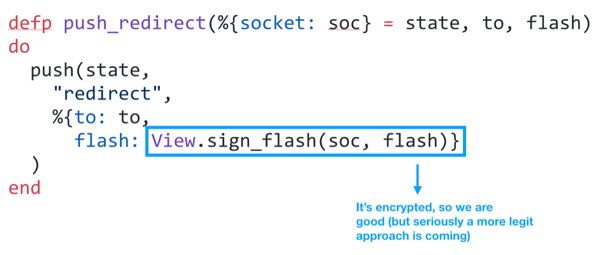LiveView storing Session Data on Redirect
This article is based on a very early version of LiveView and is here for historical purposes only.
As part of my talk at EMPEX 2019 on LiveView,
I showed a (hackish) way of using encrypted :flash messages as a means
to communicate information from the LiveView websocket to the Connection Session.
If you know a better way, please reach out to me @a4word to discuss.
If you don't know about LiveView, maybe read more about that first
Problem
How can you have your LiveView login form update the user's session across pages?
Sockets do not store Sessions
LiveView makes it easy to roll out interactive forms without having to
write custom JavaScript. But what if that form wants to store a user
record in Session to keep her logged in between pages.
Yes, you could create a single-page-app (SPA) and have the socket maintain the state. But, we are not building a SPA here.
The reason this is not straight straight forward is that LiveView
communicates with your server through a WebSocket Channel, but your
sessions are managed using Connection (aka conn) Session. So we need
a way to securely tell LiveView connection on redirect that our user
is logged in.
Sharing Flash Messages
In web applications, when you do something great (or terrible perhaps) most frameworks (Phoenix included) allow you to drop a one-time message into your flow, typically called Flash Messages
Here's a typical usage (non-LiveView).
defmodule HelloWeb.PageController do
...
def index(conn, _params) do
conn
|> put_flash(:info, "Welcome to Phoenix, from flash info!")
|> put_flash(:error, "Let's pretend we have an error.")
|> render("index.html")
end
endTwo interesting things to note:
- Phoenix does not care about the keys you use.
- Flash messages can be complex structures (just so long as they can be JSON encoded)
So, we could just as easily store a flash message like
defmodule HelloWeb.PageController do
...
def index(conn, _params) do
conn
|> put_flash(:info, %{title: "Welcome to Phoenix", subtitle: "One time flash info!")
|> render("index.html")
end
endAnd then in your template you can unwrap the flash message
<%= if msg = get_flash(@conn, :info) do %>
<h1><%= msg[:title] %></h1>
<h2><%= msg[:subtitle] %></h2>
<% end %>LiveView Flash
To break out of LiveView, you can redirect to a new page. At it's simplest it looks like
{:stop, socket |> redirect(to: "/somewhere_else")}And this supports adding Flash messages, for example
{:stop,
socket
|> put_flash(:info, "Welcome")
|> redirect(to: "/account")
}If you dig into the Phoenix and LiveView code, you will see that this information is encrypted between the server and client to avoid the client writing their own flash messages.

Using Flash to pass along login success
Knowing that the flash messages can contain any JSONable record, and that those messages are encrypted, we can use that that flash information from the LiveView genserver back to the server.

In friendly copy and paste code...
def handle_event("join-mailing-list", %{"email" => email, "password" => password}, socket) do
validate(email, password)
|> case do
:ok ->
socket
|> put_flash(:user, %{email: email})
|> redirect(to: "/account")
|> socket_reply(:stop)
:error ->
socket
|> assign(:msg, "Unable to validate your account.")
|> socket_reply()
end
end
defp socket_reply(socket, reply \ :noreply), do: {reply, socket}
On the server connection, we can then look at the :user flash message
to check if we were logged in from LiveView

In friendly copy and paste code...
defp set_from_flash(conn) do
conn
|> Phoenix.Controller.get_flash(conn, :user)
|> case do
nil -> conn
user -> conn |> assigns(:user, user)
end
endAs LiveView evolves, this process for managing session between the socket and the session might change. For now, this mechanism works and I believe provides a secure means of supporting session control between pages when using LiveView.